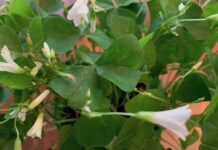
Nitrogen, Trefoils® Cookies, and Record Breaking Leaflets For St. Patrick’s Day
It’s St. Patrick’s Day and shamrock decor will be in abundance! And though it’s a botanical mystery as to which exact plant species the shamrock symbolizes, here in the U.S. we generally think of the Dutch white clover (Trifolium repens) found in many lawns. (False Shamrock, or Oxalis regnellii, pictured right, isn’t actually clover, and is what you will generally see sold in grocery stores and nurseries.)
A perennial plant, white clover is native to Europe, and shows up in turfgrass by way of seed dispersal, according to an article by Christa Carignan, Maryland Certified Professional Horticulturist, Coordinator, University of Maryland Extension Home & Garden Information Center. Here’s more from Carignan: Prior to the introduction of broadleaf herbicides in the 1950s, clover was a valued component of lawn seed mixtures for its ability to fix nitrogen, enrich the soil, and improve turfgrass growth. Clover also adds diversity to lawns and provides food for bees.
All clovers are legumes. Through a symbiotic relationship with Rhizobium soil bacteria, legumes are able to transform atmospheric nitrogen gas into an organic form of nitrogen that can be used by plants. In 2019, the University of Maryland conducted research on microclover, smaller varieties of Dutch white clover, used in combination with turf-type tall fescue. Trifolium repens var. ‘Pirouette’ and ‘Pipolina’ have smaller leaves, fewer flowers, and a lower growth habit. They also have a less aggressive clump-forming habit. Here’s what the University of Maryland study found:
Turfgrass Microclover Advantages
- Mixes well with turf-type tall fescue (and Kentucky bluegrass) and provides a uniform appearance;
- Provides an organic source of nitrogen (in grass clippings and as it decays) to support turfgrass growth; may reduce one nitrogen application per year; and
- Flowers provide a food source for bees.
Turfgrass Microclover Disadvantages
- Does not tolerate high heat and drought; starts to die when cool-season turfgrass enters dormancy in the summer; requires reseeding for persistence;
- Top growth dies back in the winter which can leave bare spots and lead to erosion;
- Poor shade tolerance;
- Seeds are expensive and not readily available in retail stores;
- Most broadleaf herbicides labeled for use on tall-fescue will kill microclover;
- Bees attracted to the flowers may be undesirable for people with bee sting allergies; and
- Southern blight disease can be a problem occasionally in prolonged periods of high humidity and high nighttime temperatures.
Even with pros and cons, people are rediscovering clover in an effort to use less chemicals in their yard. An article this Fall from George and Becky Lohmiller in the Farmer’s Almanac, pointed out a few more advantages of white clover in lawns: it’s a rapid spreader that crowds out broadleaf weeds; and it’s among the first plants to green up in Spring. Here are their tips for planting clover in turfgrass:
- Only mix 5 to 10% by weight of tiny clover seed with the recommended amount of grass seed to create a thick stand.
- When adding clover to an existing lawn, first mow it close and remove any thatch.
- To sow clover alone, mix it with enough sand to facilitate spreading. About 2 ounces of clover is needed for every 1,000 square feet of lawn.
- Since clover has a low growth habit, it can go without mowing all season long if desired.
White Dutch Clover Seed is available here at SiteOne Landscape Supply.
Getting Lucky

A white clover leaf, generally, only has three leaflets – which is why the species name is Trifolium; ‘tri’ means three.” According to livescience.com, “There are about 300 species in the clover genus Trifolium, or trefoil.” (Suddenly, the Girl Scout cookie Trefoils® makes perfect sense! It’s shaped like the Girl Scout symbol of a clover.)
So if Trifolium repens has three leaves, how do we get lucky four-leaf clovers? “Four leaf clovers are believed to be mutations of the white clover. They are also said to be quite uncommon, with only about 1 in 10,000 plants producing a clover with four leaves,” writes Nikki Tilley, author of The Bulb-o-licius Garden, in a post on gardeningknowhow.com.
She continues, “So if it’s been said that about one out of every 10,000 clovers will have four leaves and nearly 200 clovers are found in a 24” square plot, what does this mean exactly? And what are your chances of finding four leaf clovers? Simply put, in an area roughly 13 square feet, you should find at least one four-leaf clover.
According to the website of the Guinness Book of World Records, the most leaves ever found on a clover stem is 56 and was discovered by Shigeo Obara of Hanamaki City, Iwate, Japan, on 10 May 2009.











![[VIDEO] Dickies®: Discover Workwear That’s Anything But Uniform](https://turfmagazine.com/wp-content/uploads/2023/06/1647663814-4b1a2a7742790a9b1e97a3b963477850192e1d6a9dfba9b07214a77bae25d6e3-d-218x150.jpg)






























![[VIDEO] Dickies®: Discover Workwear That’s Anything But Uniform](https://turfmagazine.com/wp-content/uploads/2023/06/1647663814-4b1a2a7742790a9b1e97a3b963477850192e1d6a9dfba9b07214a77bae25d6e3-d-324x160.jpg)